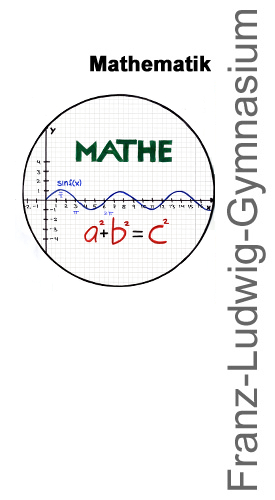M10Schulheft: Unterschied zwischen den Versionen
Aus FLG Wiki
Zur Navigation springenZur Suche springenBa2282 (Diskussion | Beiträge) (Die Seite wurde neu angelegt: „link=Mathematik|right ==1. Exponentielles Wachstum und Logarithmus == ====Exponentialfunktionen==== {| border="1" cellspacing="0"…“) |
Ba2282 (Diskussion | Beiträge) |
||
| (Eine dazwischenliegende Version desselben Benutzers wird nicht angezeigt) | |||
| Zeile 39: | Zeile 39: | ||
{| border="1" cellspacing="0" cellpadding="10" | {| border="1" cellspacing="0" cellpadding="10" | ||
|<math> log_{b}(a) = \frac{log_{n}(a)}{log_{n}(b)} \ </math> | |<math> log_{b}(a) = \frac{log_{n}(a)}{log_{n}(b)} \ </math> | ||
| + | |} | ||
| + | |||
| + | |||
| + | ==2. Zusammengesetzte Zufallsexperimente== | ||
| + | |||
| + | |||
| + | ==3. Sinus- und Kosinusfunktion== | ||
| + | |||
| + | ====Das Bogenmaß eines Winkels==== | ||
| + | |||
| + | {| border="1" cellspacing="0" cellpadding="10" | ||
| + | |<math> \frac{\alpha_{Grad}}{360^{o}} = \frac{\alpha_{Bogen}}{180^{o}}</math> | ||
| + | |} | ||
| + | |||
| + | |||
| + | {| border="1" cellspacing="0" cellpadding="10" | ||
| + | |<math> b = \varphi_{Bogen} \cdot r </math> | ||
| + | |} | ||
| + | |||
| + | ====Sinus und Kosinus am Einheitskreis==== | ||
| + | |||
| + | {| border="1" cellspacing="0" cellpadding="10" | ||
| + | |<math> -1 \leq sin(\alpha) \leq 1</math> | ||
| + | |<math> -1 \leq cos(\alpha) \leq 1</math> | ||
| + | |<math> -\infty \leq tan(\alpha) \leq \infty</math> | ||
| + | |} | ||
| + | |||
| + | |||
| + | {| border="1" cellspacing="0" cellpadding="10" | ||
| + | |<math> sin^{2}(\alpha)+cos^{2}(\alpha)=1 \ </math> | ||
| + | |<math> tan(\alpha)=\frac{sin(\alpha)}{cos(\alpha)} \ </math> | ||
| + | |} | ||
| + | |||
| + | |||
| + | {| border="1" cellspacing="0" cellpadding="10" | ||
| + | |<math> sin(\alpha)=cos(90^{o}-\alpha) \ </math> | ||
| + | |<math> cos(\alpha)=sin(90^{o}-\alpha) \ </math> | ||
| + | |} | ||
| + | |||
| + | |||
| + | ====Der Sinussatz==== | ||
| + | |||
| + | {| border="1" cellspacing="0" cellpadding="10" | ||
| + | |<math> \frac{a}{sin(\alpha)} = \frac{b}{sin(\beta)} = \frac{c}{sin(\gamma)}</math> | ||
| + | |} | ||
| + | |||
| + | |||
| + | ====Der Kosinussatz==== | ||
| + | |||
| + | {| border="1" cellspacing="0" cellpadding="10" | ||
| + | |<math> a^{2}=b^{2}+c^{2}-2bc\cdot cos(\alpha)</math> | ||
| + | |<math> b^{2}=c^{2}+a^{2}-2ca\cdot cos(\beta)</math> | ||
| + | |<math> c^{2}=a^{2}+b^{2}-2ab\cdot cos(\gamma)</math> | ||
| + | |} | ||
| + | |||
| + | |||
| + | ====Trigonometrische Funktionen und ihre Graphen==== | ||
| + | |||
| + | {| border="1" cellspacing="0" cellpadding="10" | ||
| + | |<math> sin(x + k\cdot \pi)=sin(x) \ </math> | ||
| + | |<math> cos(x + k\cdot \pi)=cos(x) \ </math> | ||
| + | |} | ||
| + | |||
| + | |||
| + | ====Die allgemeine Sinusfunktion==== | ||
| + | |||
| + | {| border="1" cellspacing="0" cellpadding="10" | ||
| + | |<math> f(x) = a \cdot sin(bx + c) +d \ </math> | ||
| + | |} | ||
| + | |||
| + | |||
| + | ==4. Ganzrationale Funktionen== | ||
| + | |||
| + | ====Eigenschaften==== | ||
| + | |||
| + | ====Nullstellen==== | ||
| + | |||
| + | ====Symmetire==== | ||
| + | |||
| + | |||
| + | ==5. Raumgeometrie== | ||
| + | |||
| + | ====Pyramiden und Kegel==== | ||
| + | |||
| + | ====Volumen der Kugel==== | ||
| + | |||
| + | {| border="1" cellspacing="0" cellpadding="10" | ||
| + | |<math> V_{Kugel} = \frac{4}{3} \cdot r^{3} \pi </math> | ||
| + | |} | ||
| + | |||
| + | |||
| + | ====Oberfläche der Kugel==== | ||
| + | |||
| + | {| border="1" cellspacing="0" cellpadding="10" | ||
| + | |<math> O_{Kugel} = 4 \pi r^{2} \ </math> | ||
|} | |} | ||
Aktuelle Version vom 14. September 2022, 18:41 Uhr
Inhaltsverzeichnis
1. Exponentielles Wachstum und Logarithmus
Exponentialfunktionen
Logarithmen
2. Zusammengesetzte Zufallsexperimente
3. Sinus- und Kosinusfunktion
Das Bogenmaß eines Winkels
Sinus und Kosinus am Einheitskreis
Der Sinussatz
Der Kosinussatz
Trigonometrische Funktionen und ihre Graphen
Die allgemeine Sinusfunktion
4. Ganzrationale Funktionen
Eigenschaften
Nullstellen
Symmetire
5. Raumgeometrie
Pyramiden und Kegel
Volumen der Kugel


























